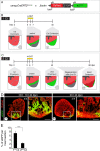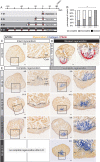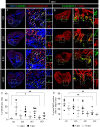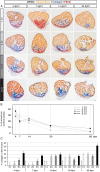Multiple cryoinjuries modulate the efficiency of zebrafish heart regeneration
- PMID: 32665622
- PMCID: PMC7360767
- DOI: 10.1038/s41598-020-68200-1
Multiple cryoinjuries modulate the efficiency of zebrafish heart regeneration
Abstract
Zebrafish can regenerate their damaged hearts throughout their lifespan. It is, however, unknown, whether regeneration remains effective when challenged with successive cycles of cardiac damage in the same animals. Here, we assessed ventricular restoration after two, three and six cryoinjuries interspaced by recovery periods. Using transgenic cell-lineage tracing analysis, we demonstrated that the second cryoinjury damages the regenerated area from the preceding injury, validating the experimental approach. We identified that after multiple cryoinjuries, all hearts regrow a thickened myocardium, similarly to hearts after one cryoinjury. However, the efficiency of scar resorption decreased with the number of repeated cryoinjuries. After six cryoinjuries, all examined hearts failed to completely resolve the fibrotic tissue, demonstrating reduced myocardial restoration. This phenotype was associated with enhanced recruitment of neutrophils and decreased cardiomyocyte proliferation and dedifferentiation at the early regenerative phase. Furthermore, we found that each repeated cryoinjury increased the accumulation of collagen at the injury site. Our analysis demonstrates that the cardiac regenerative program can be successfully activated many times, despite a persisting scar in the wounded area. This finding provides a new perspective for regenerative therapies, aiming in stimulation of organ regeneration in the presence of fibrotic tissue in mammalian models and humans.
Conflict of interest statement
The authors declare no competing interests.
Figures







Similar articles
-
Is zebrafish heart regeneration "complete"? Lineage-restricted cardiomyocytes proliferate to pre-injury numbers but some fail to differentiate in fibrotic hearts.Dev Biol. 2021 Mar;471:106-118. doi: 10.1016/j.ydbio.2020.12.004. Epub 2020 Dec 10. Dev Biol. 2021. PMID: 33309949
-
Extensive scar formation and regression during heart regeneration after cryoinjury in zebrafish.Development. 2011 May;138(9):1663-74. doi: 10.1242/dev.060897. Epub 2011 Mar 23. Development. 2011. PMID: 21429987
-
Differential regenerative capacity of neonatal mouse hearts after cryoinjury.Dev Biol. 2015 Mar 1;399(1):91-99. doi: 10.1016/j.ydbio.2014.12.018. Epub 2014 Dec 31. Dev Biol. 2015. PMID: 25555840 Free PMC article.
-
Cellular and Molecular Mechanism of Cardiac Regeneration: A Comparison of Newts, Zebrafish, and Mammals.Biomolecules. 2020 Aug 19;10(9):1204. doi: 10.3390/biom10091204. Biomolecules. 2020. PMID: 32825069 Free PMC article. Review.
-
A Systematic Exposition of Methods used for Quantification of Heart Regeneration after Apex Resection in Zebrafish.Cells. 2020 Feb 26;9(3):548. doi: 10.3390/cells9030548. Cells. 2020. PMID: 32111059 Free PMC article.
Cited by
-
Hippo-Yap/Taz signalling in zebrafish regeneration.NPJ Regen Med. 2022 Jan 27;7(1):9. doi: 10.1038/s41536-022-00209-8. NPJ Regen Med. 2022. PMID: 35087046 Free PMC article. Review.
-
Persistent Ventricle Partitioning in the Adult Zebrafish Heart.J Cardiovasc Dev Dis. 2021 Apr 9;8(4):41. doi: 10.3390/jcdd8040041. J Cardiovasc Dev Dis. 2021. PMID: 33918756 Free PMC article.
-
Using Zebrafish as a Disease Model to Study Fibrotic Disease.Int J Mol Sci. 2021 Jun 15;22(12):6404. doi: 10.3390/ijms22126404. Int J Mol Sci. 2021. PMID: 34203824 Free PMC article. Review.
-
Finding Solutions for Fibrosis: Understanding the Innate Mechanisms Used by Super-Regenerator Vertebrates to Combat Scarring.Adv Sci (Weinh). 2021 Aug;8(15):e2100407. doi: 10.1002/advs.202100407. Epub 2021 May 24. Adv Sci (Weinh). 2021. PMID: 34032013 Free PMC article. Review.
-
Zebrafish as a Model for Cardiovascular and Metabolic Disease: The Future of Precision Medicine.Biomedicines. 2024 Mar 20;12(3):693. doi: 10.3390/biomedicines12030693. Biomedicines. 2024. PMID: 38540306 Free PMC article. Review.
References
-
- Lenhoff H, Lenhoff S. A History of Regenertion Research: Milestones in the Evolution of a Science. Cambridge: Cambridge University Press; 1991. pp. 47–66.
Publication types
MeSH terms
Grants and funding
LinkOut - more resources
Full Text Sources
Molecular Biology Databases

